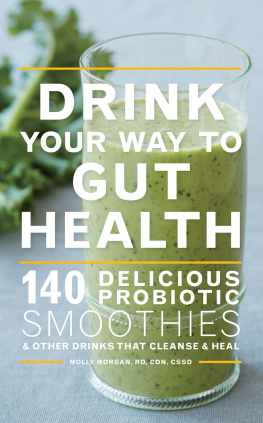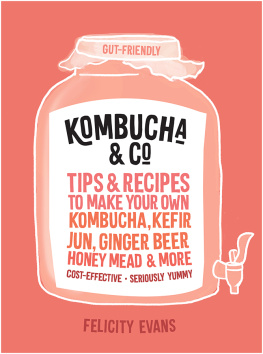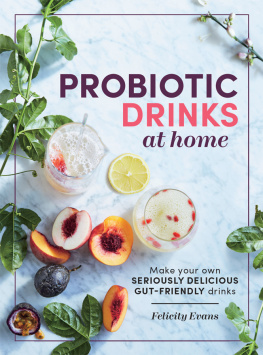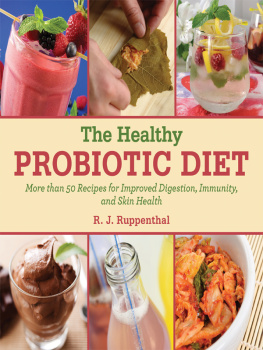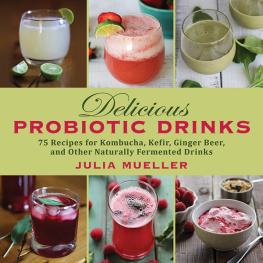A Hollan Publishing, Inc. Concept
Copyright 2015 by Molly Morgan
Photography 2015 by Linda Xiao
Food styling by Molly Shuster
Prop styling by Maeve Sheridan
All rights reserved.
For information about permission to reproduce selections from this book, write to Permissions, Houghton Mifflin Harcourt Publishing Company, 215 Park Avenue South, New York, New York 10003.
www.hmhco.com
Library of Congress Cataloging-in-Publication Data
Morgan, Molly.
Drink your way to gut health : over 140 delicious probiotic smoothies and other drinks that cleanse and heal / Molly Morgan, RD, CDN, CSSD.
Pages cm
Includes index.
ISBN 978-0-544-45174-2 (trade paper); 978-0-544-45176-6 (ebk)
Probiotics. 2. Smoothies (Beverages)Therapeutic use. 3. BeveragesTherapeutic use. 4. Gastrointestinal systemMicrobiology. I. Title
RM666.P835M67 2015
641.2dc23
2014025821
v1.0315
To my taste testers and supportersmy husband and our two little guys.
table
of
contents
acknowledgments
I am forever thankful to my patient, loyal, and caring husband for his ongoing support. Especially for his encouragement throughout the development of this book (from the days when our refrigerator looked like a science experiment), for his recipe ideas, and for discussing the volumes of research to support this book. Next, thank you to our two sons, who at times may have grown tired of listening to the sound of the blender, yet happily tasted and provided valuable feedback and ideas that were incorporated into the recipes. Lastly, I need to thank my wonderful parents, in-laws, and family for their always enthusiastic backing.
This book went from concept to reality thanks to Holly Schmidt of Hollan Publishing; without her the book would not have been possible. Thank you to Justin Schwartz and Houghton Mifflin Harcourt for their trust in me and commitment to publishing this book. Moreover, to all of those who had a part in making the content of this book come together, from the editors and photographers, to the designersthank you!
And thank you to the readers who try these recipes as they drink their way to gut health.
introduction
The gastrointestinal (GI) tract is a complex ecosystem and home to trillions of microbes (aka bacteria)some good and some bad. There is emerging research to show that gaining a better understanding of the microbesgood and badthat reside in the GI tract could unlock deeper understanding and new ways to diagnose and treat a wide variety of diseases.
Our ancestors for tens of thousands of years were unknowingly consuming fermented foods and beverages. Over time, they began to recognize the palatability, preservative nature, and other properties that these foods delivered. While probiotics have a long history of health-helping connections, the term only appeared recently: It was first used by Daniel Lilly and Rosalie Stillwell in 1965 to describe substances secreted by one microorganism that simulate the growth of another.
Today probiotics are often referred to as good bacteria, and are increasingly being linked to health benefits, including improving gastrointestinal health, helping conditions like psoriasis and chronic fatigue syndrome, and even potentially playing a role in obesity and mental health. The microbes in our intestines also provide us with a barrier to infection, provide metabolic fuel, and contribute to normal immune development.
There are basic probiotic-rich ingredients that form the foundation of the recipes in this book, including buttermilk, yogurt, cultured nondairy yogurt, filmjlk, frozen yogurt, kefir, kombucha tea, ginger beer, miso, and tempeh. It has been found that there are also small amounts of probiotics in soy milk and almond milk. In this book you will find DIY recipes for many of these ingredients, including almond milk for making nondairy versions of yogurt, as they will serve as the base for other beverages.
There are other foods that are probiotic rich, including natto, sauerkraut, sourdough bread, pickles, soft cheese (like Gouda), kimchi, and olives. Although you will find only one of the foods (the pickles in ) in the drink recipes, try working them into your eating routine for an intestinal boost!
food first, supplements second
In response to the growing interest in probiotics, there is an increase in the number of probiotic supplements popping up on the market. When it comes to taking supplements, remember that a dietary supplement is defined as a product intended for ingestion that contains a dietary ingredient intended to add further nutritional value to (supplement) the diet. The key piece of the definition is to add further nutritional valuein other words, you must first consume the nutrients your body needs from foods, and supplements are intended to add further nutritional value, not to become a crutch for poor eating habits.
First get probiotics from your food and beverages, then if you still need to add further probiotics, work with a registered dietitian and your health care provider to carefully consider adding a supplement. What you will quickly realize is that there is a wide variety of ways to add probiotics to your daily routineif you dont like yogurt, try kefir; if you dont prefer kefir, try ginger beer. And always remember, it can take time to learn to like new foods, flavors, and texturesby being adventurous, I am confident that anyone can find probiotic foods and beverages to add to their eating routine.
the prebiotic connection
There is another group of foods, called prebiotics, that are linked to improving overall intestinal health. They are non-digestible and non-absorbable carbohydrates that help feed the good bacteria that are already living in the digestive system.
Examples of prebiotic foods include: bananas, asparagus, leeks, onion, garlic, almonds, pistachios, red wine, honey, maple syrup, oatmeal, whole grains, and legumes. Throughout the recipes in this book, you will find many prebiotic foods added to the recipes to help boost the potential power of the probiotics in your digestive tract.
Research has found benefits from a wide range of prebiotics, including: fructo-oligosaccharides (FOS), polyfructan inulin, galacto-oligosaccharides (GOS), and lactulose. For example, FOS has been found to increase calcium absorption; food sources include wheat, barley, bananas, asparagus, tomatoes, onions, leeks, garlic, and agave. And lactulose is widely used to treat constipation.
Other potential prebiotics include lactitol, xylo-oligosaccharides, isomalto-oligosaccharides, soybean oligosaccharides (raffinose and stachyose), lactosucrose, resistant starch, and cereal fibers.
the health connection
The connection between probiotics and health seems to lie within our intestinal tract, which is inhabited by trillions of microbes.
Early discovery of probiotic benefits is credited to the Russian scientist Elie Metchnikoff for his work on the positive role that probiotics have on health. In his book The Prolongation of Life (1907), he suggested that foods like yogurt, kefir, and sour milk (containing lactic acid bacteria) were associated with good health and longevity. His reports were based on the Bulgarian peasants who consumed large quantities of sour milk, and lived longer than the average population.

